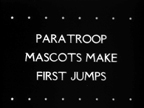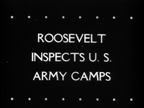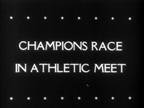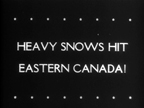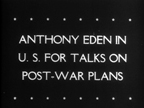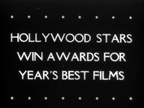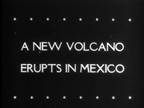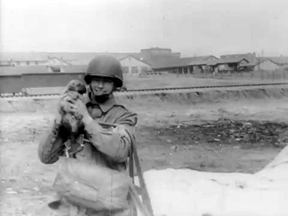Are you
- Working on a project that needs National Archives footage?
- Wondering when the National Archives will reopen?
- Tired of paying exorbitant prices for 15-second stock footage clips?
- Perplexed by signing licensing agreements for footage that resides in the public domain?
- Looking for free bonus footage?
If you answered yes to any of these questions, you are in the right place. We have thousands of native scanned high definition film transfers, spanning all the popular National Archives Record Groups, available as 1920×1080/24p ProRes422 files—downloadable for your project. Our customer service team is ready to reply to new requests in a matter of hours.
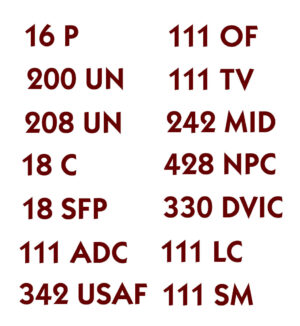
You provide the National Archives Local ID numbers and we’ll let you know if the titles are available in our collection. Stretch your dollars! An average 15-second “hi-def” clip can cost $120 at stock footage outfits. Here at FFS, you can get an entire 10-minute story for $120!
Follow the Numbers
The FFS collection includes thousands of archival treasures from the National Archives. See a few examples in our store. You’ll need to find the titles you want in the National Archives Online Catalog and record their corresponding Local Identifier Numbers.
Buy 3 get the 4th file free.
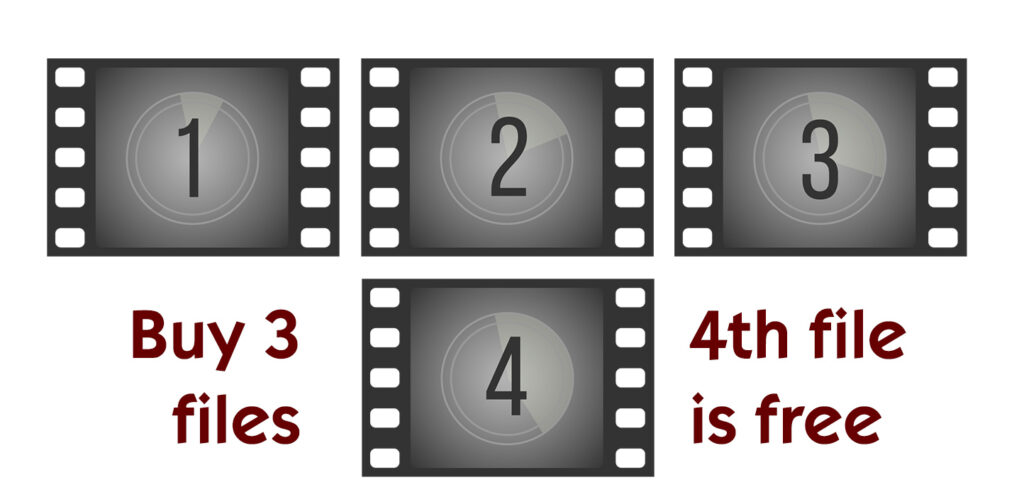
When you’re ready to order, send us your final list and we’ll send you an invoice. For every 3 files, you get the 4th file of the same or lesser value free. Offer ends September 15, 2020.

Screener Special
To receive up to 5 free screeners, include the special code provided in our promotion email. Since screeners normally cost $5 each, you can get up to $25 worth of free screeners. Offer ends September 15, 2020.
National Archives Identification Numbers Hunt
To order titles you need to understand the National Archives nomenclature. As one might expect, the holdings are organized into categories or Record Groups. See our Deciphering the NARA Code for an introduction to the categories.
Step One: Research the National Archives catalog
- To find titles in the catalog input keywords or titles if you have one in mind. Here’s an example, searching for titles related to the Berlin Airlift of 1948-1949. We typed in Berlin Airlift into the search box and hit ENTER.

- The results include all types of materials: charts, documents, photographs, and moving images. Our results show 63 pages of possibilities! We need to narrow them down to just Moving Images.
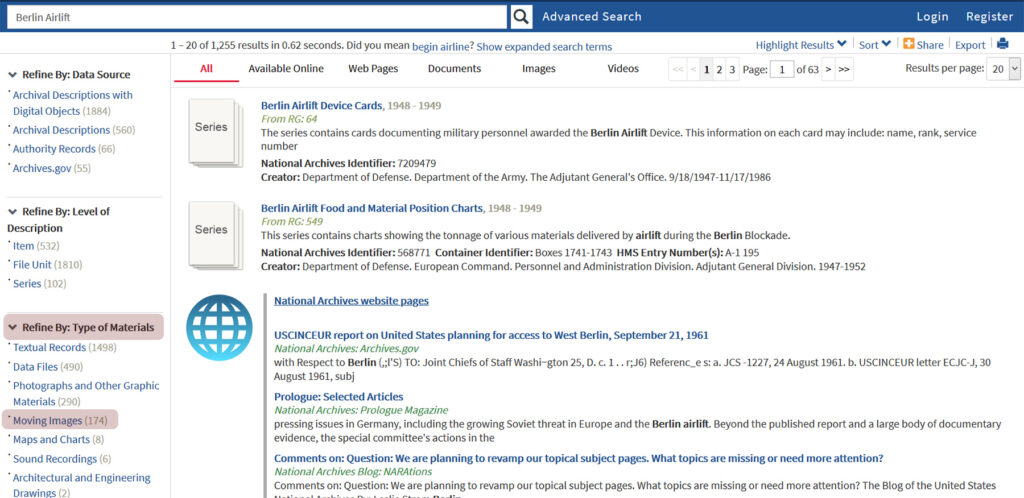
- Look in the left sidebar (column) under Refine by Type of Materials and select Moving Image Items to limit your search results. Now we have only 5 pages and 87 moving image candidates. It’s time to start checking out titles of interest.

- Click on a promising title. In our hunt we found Airlift: Working for Humanity on page 2. Having read the description, we want to find out if it is in the FFS Collection. To add it to our list of hopefuls, we’ll need the Local Identifier number.
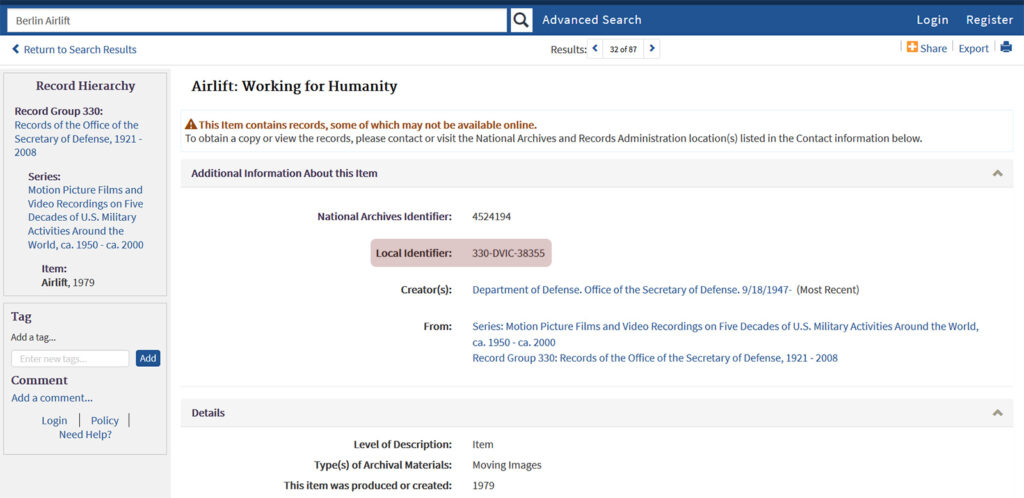
- Find the Local Identifier for each title of interest. In our example, the ID is 330-DVIC-38355. Make sure to include the dashes, spaces or periods exactly as displayed for each title you find.
Here’s a closer view.

Step Two: Compile your list of hopefuls and send it to us.
- Once you have found Local ID numbers of interest, email the list to us at promo@filmfileshop.com. We’ll search the FFS database and let you know what we find within hours. Please submit at least 5 Local ID numbers. We are not able to search for less than 5 Local ID numbers at a time. We cannot perform keyword searches. You must know the Local ID number. Including the title along with the ID number is helpful as a cross reference.
- To receive up to 5 free screeners, include the special code provided in our promotion email. Since screeners normally cost $5 each, you can get up to $25 worth of free screeners.
Step Three: Order and receive the clips
- When you are ready to order, send us your final list and we’ll send you an invoice out of our Paypal account. For every 3 files, you get the 4th file of the same or lesser value free.
- Once the invoice is paid and the files have been uploaded you will receive an email with the download links to your high definition 1920×1080/24p ProRes422 files.
- As with all our online sales, sales are final. Please see our Terms and Conditions.
Download the PDF version of the above “tutorial” with a sample list
Start your hunt today!



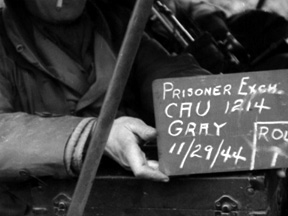 The FilmFileShop collection is made up of more than newsreels. If you imagine the different types of movies as part of a large tree, then the newsreels are part of a major “branch” called documentaries. Although the term “documentary” was not coined until 1926 (attributed to John Grierson), the first “movie goers” witnessed the seeds of the documentary. The titles provide the clues: “Workers Leaving the Lumiere Factory in Lyon” and “Train Arriving at the Station” (both from 1895, by the Lumiere Brothers, France). The very earliest of films also offered scenes from faraway places and events of the day, such as the Coronation of Tsar Nicholas II, 1896, in Russia. The movie camera was capturing “eye witnessed,” live action events and scenes “on location.” Enthusiasm for exotic and novelty “actuality” footage fueled expeditions and adventures.
The FilmFileShop collection is made up of more than newsreels. If you imagine the different types of movies as part of a large tree, then the newsreels are part of a major “branch” called documentaries. Although the term “documentary” was not coined until 1926 (attributed to John Grierson), the first “movie goers” witnessed the seeds of the documentary. The titles provide the clues: “Workers Leaving the Lumiere Factory in Lyon” and “Train Arriving at the Station” (both from 1895, by the Lumiere Brothers, France). The very earliest of films also offered scenes from faraway places and events of the day, such as the Coronation of Tsar Nicholas II, 1896, in Russia. The movie camera was capturing “eye witnessed,” live action events and scenes “on location.” Enthusiasm for exotic and novelty “actuality” footage fueled expeditions and adventures.